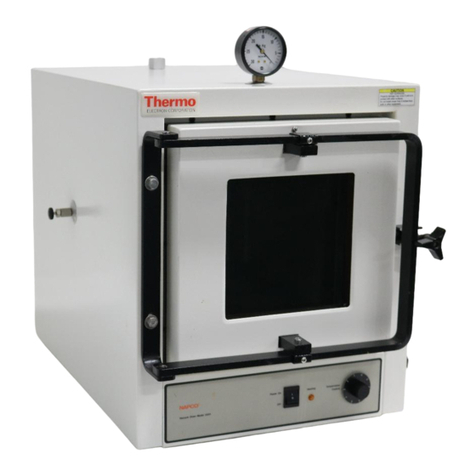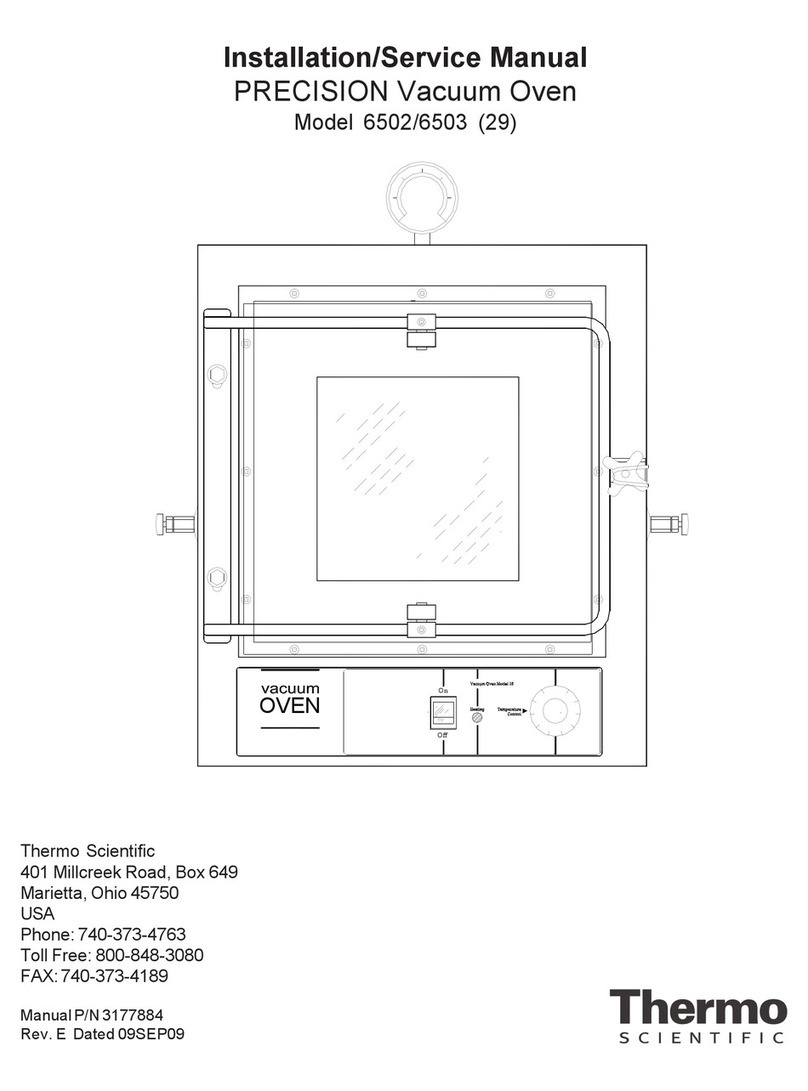Installationand Operation
Laboratory Vacuum Ovens
5.2
Setting the Temperature
To set the temperature to the desired setpoint, complete the
following steps:
1. Press
a
or
7
until the desired setpoint is indicated on the
bottom line of the display.
2. Press
SETIENT
to register the new setpoint.
5.3
Setting the OvertemperatureProtection(OTP)
Temperature
The high limit alarm system with the temperature controller
disables theheater output. To set the alarm on the temperature
controller (typically 5°C above the desired main temperature
setpoint), complete the following steps:
1. Press and hold
SETENT
for 3 seconds, until
A1
is displayed
on the upper line.
2. Press
A
or
V
until the desired overtemperature limit
setpoint shows onthe bottom line of the display.
3. Press
SETENT
to register the new overtemperature alarm
setpoint.
4. Press and hold
SETENT
for 3 seconds to return to the normal
display.
5.4
Changing Between Celsius and Fahrenheit
The controller isfactory
-
set to operate with degrees Celsius. To
change the display modes and parameter settings to the
Fahrenheit scale, you will need to change the Input Type
parameter
In
and also the values of various scale
-
dependent
parameters. If during this procedure the buttons are inactive for
more than two minutes, the controller will return to the standard
display.
To change from Celsius to Fahrenheit:
1.With the controller operating, access the Operating
Parameters menu by pressing and holding
SETIENT
for3
seconds.
2. Press and release
SETIENT
repeatedly until theupper display
reads LoC.
3. Press
V
until the displayed value of LoCis
-
1; then press
SETIENT
to access the Setup Parameters menu (refer to
Table 2 on page
5).
4. The first setup parameter displayed is Input 'Qpe (In). Press
tochange its value from
5
to 35. After making this
adjustment (andall following parameter adjustments) be sure
topress and release
SETIENT
again to register the change.
5. Press and release
SETIENT
to advance to theSPH parameter
and change its value to 500.
6. Press and release
SETIENT
to advance to theSPL parameter
and change its value to 32.
7.
Press and release
SETENT
to advanceto the HY1 parameter
and change its value to
1.
8.
Press and hold
SETENT
for 3 seconds to exit theSetup
Parameters Menu.
9.
Press and hold
SETIENT
for 3 seconds toenter the Operating
Parameters Menu anddisplay the A1 parameter.
10.Usethe Abutton to set the
A1
parameter to the desired
overtemperature limit in OF.
11. Press and release
SETIENT
to advanceto the P parameterand
change its value to 16.2.
12. Press and hold
SETIENT
for 3 seconds to exit theOperating
Parameters Menu.
13. The new temperature units are now effective. Follow the
instructions inSection 5.2 to reset the temperature setpointin
"
E
14. Apply the OF label over the "C label on the control panel.
5.5
Setting the Ramp to SetpointRate
The Ramp Ratefeature allows the chamber to beheated or
cooled at any rate slower than the maximum capability of the
unit. To fine tune ramp rates, you may need to test using loads
with similar mass and thermal properties to loads you intend to
usein oven applications.
To set the ramp to setpoint time, complete the following steps. If
during this procedure the buttons are inactive for more than two
minutes, the controller will return to the standard display.
1.
With the controller operating, press and hold
SETIENT
for
3
seconds to enter the Operating Parameters menu.
2. Press and release
SETIENT
until the LoC parameter is on the
upper display.
3. Press the down arrow button toshow '-I1,and press
SETIENT
once to enter theSetup Parameters menu.
4.
Press and release
SETIENT
until the Upr parameter is on the
upper display.
5. Press the arrow buttons to select the new Up Ramp Rate
value, in OC per minute or OF per minute, or 'OFF'. Press and
release
SETENT
to register the value change.
6. Press and release
SETIENT
until the dnrparameteris on the
upper display.
7.
Press the arrow buttons to select the new Down Ramp Rate
value, in OC per minute or OF per minute, or 'OFF'. Press and
release
SETIENT
to register the value change.
8.
Press and hold
SETENT
for three seconds to exit the Setup
Parameters menu.
9.
The new Ramp Rates are now effective.
10. Follow theinstructions inSection 5.2 toreset thetemperature
setpoint.
Note:
The ramp rate begins when the
SET/ENT
buttonis
pressedafter the target setpoint is selected. The setpoint
display on the controllerwill show the changing setpoint
at the selected ramp rate.
To view the target setpoint during theramp rate,press andrelease
an arrow button. Thelower display will show the setpointnext to
the selected target setpoint. Return to the ramping setpoint
display by pressing and releasing the other arrow button.






































